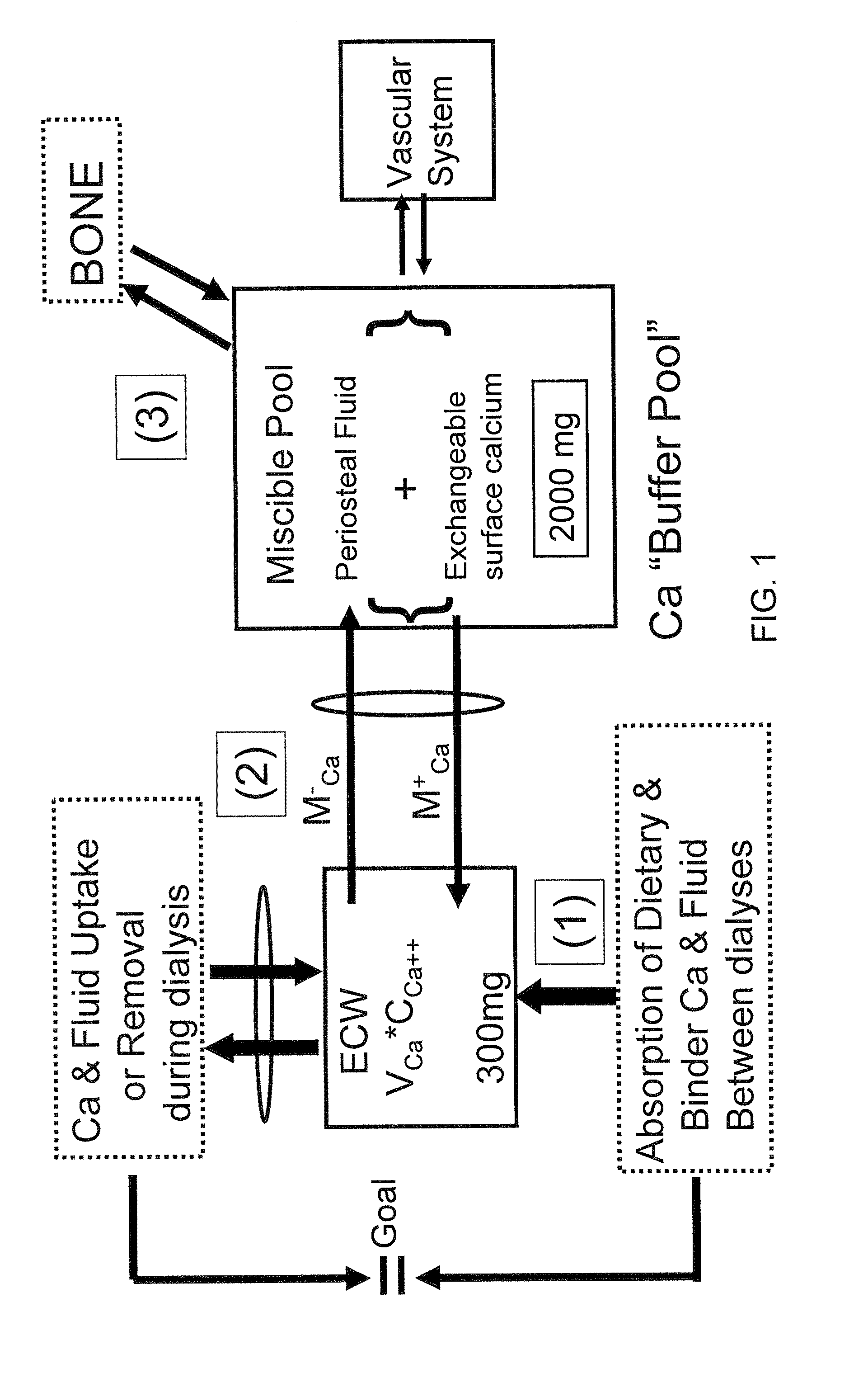Method of Determining A Phosphorus Binder Dosage for a Dialysis Patient
a dialysis patient and phosphorus binder technology, applied in the field of determining the dosage of phosphorus binder for a dialysis patient, can solve the problems of dialysis patients' morbidity and mortality, hyperexcitability and tetanic convulsions, and vascular calcification is particularly problematic in dialysis, so as to prevent potentially undesired accumulation or depletion of calcium and/or phosphorus. , to achieve the
- Summary
- Abstract
- Description
- Claims
- Application Information
AI Technical Summary
Benefits of technology
Problems solved by technology
Method used
Image
Examples
example 1
[0078]Nine hemodialysis patients (Pt) were monitored during 32 dialyses with high flux dialyzers (180NR), blood & dialysate flows of 400 ml / min and 500 ml / min, respectively, and CdiCa++ of 1.75 to 3.0 mEq / L. Data measured: plasma Ca++ (CpCa++Meas) at t=0, 60 min and end dialysis; CdiCa++ and CdoCa++ (outflow) every 10 min with NOVA 8 (calcium ion sensitive electrode) in 2 Pts (D10) and by dialysate collection in 7 Pts (DCOL). A previously described Ca Kinetic model (Blood Purifi 25:139-149, 2007) was used to calculate: convective and diffusive Ca flux (JCCa, JDCa); mobilization or sequestration of Ca (MCa) in the Miscible Calcium Pool (MCP); Ca++ mass balance (CaMB) and CpCa (CpCa++Calc) every 10 min in D10 and thrice in DCOL. The D10 model was validated from comparison of CpCa++Meas to the values for CpCa++Calc (calculated from Ca flux and dialysance). CaMB was calculated as function of (CdiCa++—CpiCa++) and a Miscible Calcium Pool Buffer Coefficient (KMP) as KMP=MCa / (MCa+JdCa), wh...
example 2
[0082]Patient 1 was a 53 year old diabetic, African-American male with a dialysis vintage of 19 months. Prior to use of PKM modeling, the 6-month, 3-month, and 1-month average serum P was 7.0, 6.5, and 6.8 mg / dL, respectively. All of these values are outside the recommended guidelines of 3.5-5.5 mg / dL. Prior to use of PKM modeling, the 6-month average serum Ca was 9.1 mg / dL, which falls within the recommended guidelines of 8.4-9.5 mg / dL. In the 6 months prior to the study, Patient 1 was prescribed 3 (800 mg) Renagel® tablets per day. Once per month for 6 months (study months 0-5), input values were collected for the PKM model and recommended binder prescription and dialysate calcium concentrations were calculated. As illustrated in FIG. 7, during the study period, Patient 1's binder prescription was increased to 6 and then 7 PhosLo® pills (667 mg per pill) per day in order to bring serum P level down to the recommended guidelines. Additionally, as illustrated in FIG. 8, the dialysat...
example 3
[0083]Patient 2 was a 61 year old African-American male with a dialysis vintage of 41 months. Prior to use of PKM modeling, the 6-month, 3-month, and 1-month average serum P was 7.6, 7.8, and 7.7 mg / dL, respectively. All of these values are outside the recommended guidelines of 3.5-5.5 mg / dL. Prior to use of PKM modeling, the 6-month average serum Ca was 8.6 mg / dL, which falls within the recommended guidelines of 8.4-9.5 mg / dL. In the 6 months prior to the study, Patient 2 was prescribed 6 PhosLo® tablets per day. Once per month for 6 months (study months 0-5), input values were collected for the PKM model and recommended binder prescription and dialysate calcium concentrations were calculated. As illustrated in FIG. 9, during the study period, Patient 2′s binder prescription was increased to 12 and then 15 PhosLo® pills per day in order to bring serum P level down to the recommended guidelines. Additionally, as illustrated in FIG. 10, the dialysate calcium concentration was lowered...
PUM
| Property | Measurement | Unit |
|---|---|---|
| concentration | aaaaa | aaaaa |
| concentration | aaaaa | aaaaa |
| concentration | aaaaa | aaaaa |
Abstract
Description
Claims
Application Information
 Login to View More
Login to View More - R&D
- Intellectual Property
- Life Sciences
- Materials
- Tech Scout
- Unparalleled Data Quality
- Higher Quality Content
- 60% Fewer Hallucinations
Browse by: Latest US Patents, China's latest patents, Technical Efficacy Thesaurus, Application Domain, Technology Topic, Popular Technical Reports.
© 2025 PatSnap. All rights reserved.Legal|Privacy policy|Modern Slavery Act Transparency Statement|Sitemap|About US| Contact US: help@patsnap.com



